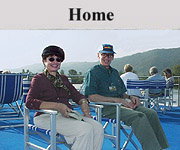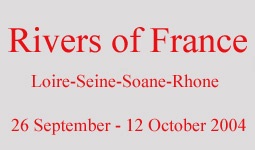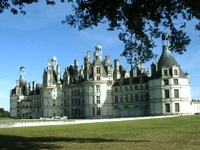Tuesday, October 5. We had arrived in Macon before we got up. After the breakfast buffet, we started a walking tour of the city at 9:00. It was a beautiful, sunny day. Most of the buildings along the river were large and relatively modern. The older section started a block or two inland. We stopped at the Church of St. Pierre (19th century), then continued to a nearby square featuring the timbered old Maison du Bois Dore (1500). At that point our guide turned us loose. Our first order of business was to buy some
bread. Each passenger had been give 50 cents for this purpose. The idea was
that there would be a wide variety of breads for the ship's dinner that
evening. After much searching without finding a boulangerie, we finally
found a patisserie with a very nice round loaf of whole grain bread. We also
did a little shopping for clothes in some small shops. We were back on board well before the 11:30
deadline, though. We found a very nice live plant in our cabin, an
anniversary gift from the tour directors and the ship's crew. The ship
sailed for Lyon at noon. There had been dozens of swans in the water while
we were docked, and we continued to see them all along the river. We entered Lyon about 4:45, and soon after sailed between what appeared to be a fortress and the Basilica of Notre Dame de Fourviere. The bridges in the city were fairly low, providing minimal clearance for the Ravel even in the very center (the highest point). In fact, at its normal height the ship's bridge could not pass under the bridges. But it had an elevator mechanism and could be lowered a few feet to allow it to clear with about three inches to spare. All of us topside had to lie or sit on the deck to avoid being struck by the bridges. The Soane and Rhone form a sharp "Y" where they meet, and the ship had to make a hard 130 degree turn to go up the Rhone to our mooring. The earliest settlement here was on this "peninsula" between the rivers. The Romans occupied the region in 43 B.C., founding the city of Lugdunum (later Lyon). Its position made it a natural hub. The three parts of Gaul mentioned by Caesar met at Lyon, and the city was the starting-point of the principal Roman roads throughout Gaul. It was only natural that Lyon became the Roman capital of Gaul. In the 5th century it became the capital of the Kingdom of Burgundy. The city's location on the main route to Italy also helped it to flourish during the Renaissance when it developed an extensive silk industry. Now, with 1.44 million inhabitants, it claims to be France's second largest urban area, after Paris. (But Marseilles has more people than Lyon in the city, itself.) The ship finally docked near the Pont Gallieni at 5:40. There was a welcoming drink in the lounge at 6:30 and the Captain's dinner at 7:00. (The welcoming drink was somewhat superfluous since unlimited wine was included with every dinner on board.) We listened to a chanteuse in the lounge until 10:00 before retiring.
| |||


